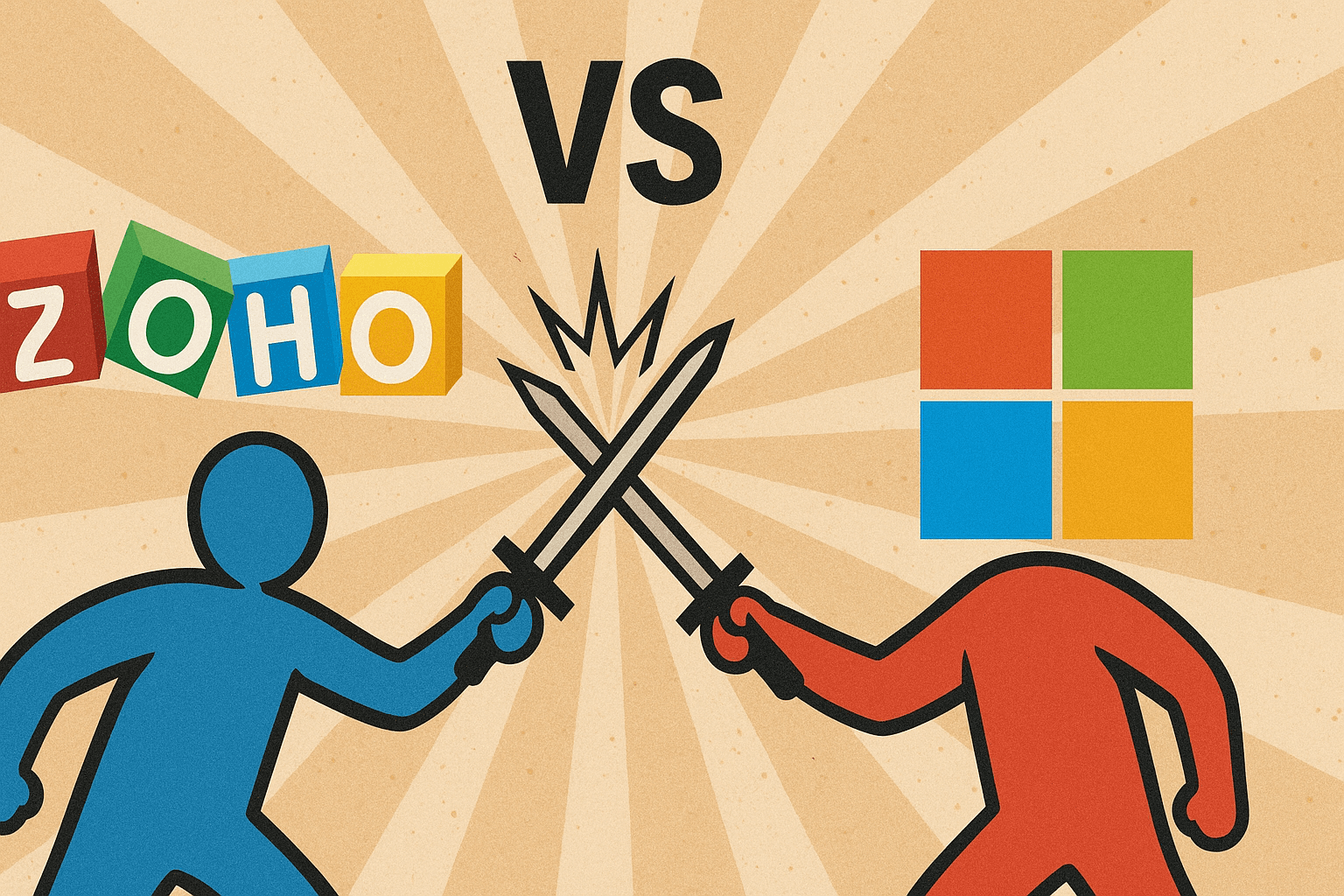Whats Matter ?
In late September 2025 a flurry of headlines and social posts pushed Zoho into direct conversation with Microsoft. Zoho’s co‑founder publicly challenged Microsoft’s dominance, India’s IT minister signalled a high‑profile switch to Zoho, and Zoho rolled out aggressive product and infrastructure claims (plus a new made‑in‑India messaging app). The moment has become less about one press release and more about a larger question: can a bootstrapped Indian SaaS company realistically compete with Microsoft at scale?
This blog breaks down the story, timelines, product and enterprise comparisons, political and strategic context, likely pitfalls, and practical recommendations for CIOs and SMB owners.
Timeline & Key Events (concise)
- Late September 2025: Zoho founder Sridhar Vembu publicly declared Zoho can ‘take on Microsoft’, urging users to compare both suites.
- Same week: India’s IT Minister announced he was switching to Zoho for documents/spreadsheets/presentations as part of a Swadeshi push.
- Same period: Zoho launched/boosted its India‑focused messaging app and reported a rapid surge in early traffic, leading to quick infrastructure scaling efforts.
- Company commitment: Zoho announced increased R&D investment across cloud infrastructure, AI and platforms.
What’s actually changed — facts vs. rhetoric
Rhetoric: Public statements and campaign visuals emphasise parity or superiority with Microsoft — breadth of apps, integrated stack, and user experience.
Facts: Zoho has built a broad portfolio (CRM, Workplace apps, ManageEngine, finance, HR, etc.) and is investing in infrastructure and AI. However, parity across every enterprise feature and global compliance footprint is not instantaneous — it’s a roadmap.
Feature-by-feature comparison (practical lens)
Productivity Suite (Docs / Sheets / Slides)
- Zoho Strengths: Lightweight, cost‑effective, good feature set for SMEs, data residency options in select regions, integrated with Zoho ecosystem.
- Microsoft Strengths: Deep feature maturity (especially in advanced collaboration, Excel power features), enterprise integrations (Azure AD, Intune), offline/desktop parity, global support and proven compliance certifications.
Practical takeaway: For cost‑sensitive SMBs and teams without heavy Excel macros/Power BI dependence, Zoho is compelling. For large enterprises with complex workflows, Microsoft still leads.
Collaboration & Communication (Teams vs Zoho Cliq / Mail / Arattai)
- Zoho: Multiple comms apps, lighter footprint, easier admin for small orgs. Recently launched India‑focused messaging (rapid growth reported).
- Microsoft: Teams is feature‑rich, tightly integrated with enterprise identity and calendaring and already embedded in many organizations.
CRM & Business Apps (Zoho CRM vs Dynamics 365)
- Zoho CRM: Extremely popular with SMBs due to pricing and rapid feature additions.
- Dynamics 365: Deeper enterprise workflows, partner ecosystem, and pre‑built industry solutions.
IT Management & Security (ManageEngine vs Microsoft Intune / Defender / Azure)
- Zoho / ManageEngine: Strong in on‑prem and hybrid IT management; attractive pricing.
- Microsoft: Broad security portfolio, advanced threat detection, and enterprise identity & access controls that many large organizations require.
Pricing and Total Cost of Ownership (TCO)
Zoho’s pricing is notably lower at entry tiers, which lowers the barrier for adoption among startups and SMBs. But TCO should account for migration costs, retraining, third‑party integrations, and potential limits in advanced features that might require custom development or 3rd party tools.
Political & Strategic Context (India’s Swadeshi push)
Government endorsements (or symbolic switches by officials) accelerate awareness and create momentum for local vendors. This has short‑term promotional power and can speed procurement pilots in public and quasi‑public sectors. But enterprise procurement still requires compliance, auditability, uptime guarantees, and vendor viability over years.
What Zoho must prove (to truly challenge Microsoft at enterprise scale)
- Global compliance & certifications across major jurisdictions (ISO, SOC2, sectoral certifications).
- Large enterprise references showing scaling of complex global deployments.
- Partner & SI ecosystem to enable industry workflows (manufacturing, finance, healthcare).
- Interoperability & migration tooling to ease moves from Microsoft stacks.
- SLAs, support models & predictable pricing for multi‑year enterprise contracts.
Risks for organizations considering a switch now
- Hidden migration costs: File fidelity (advanced Office features), Exchange→Mail migration cliff edges, identity sync issues.
- Third‑party integrations: Many niche vendors build for Microsoft-first integrations (Power Platform).
- Organizational change: User training, search behaviors, and process rewiring.
- Vendor lock‑in swap: Small vendors can be cheaper now, but long-term viability must be evaluated.
Recommendations (Actionable playbook)
- Run a pilot, not a full migration: Choose a department with low dependency on advanced Excel macros and Power Platform.
- Map critical integrations: Inventory apps depending on Microsoft services (Azure AD, Exchange, Power BI).
- Estimate migration effort: Run a 60‑90 day migration feasibility and pilot with explicit KPIs (cost savings, uptime, user satisfaction).
- Retain hybrid posture: Use Zoho for new teams / SMEs while keeping Microsoft for heavy workloads — a pragmatic two‑tier approach.
- Negotiate custom SLAs & data residency: If your business requires sovereignty or compliance, get it documented.
SEO & publishing details
SEO title: Zoho vs Microsoft: Can India’s Zoho Beat Microsoft in 2025?
Meta description: Late‑September 2025 saw Zoho publicly challenge Microsoft and India’s Swadeshi push push new attention on home‑grown SaaS. This deep analysis compares features, pricing, risks, and the path forward for businesses considering a switch.
Keywords: Zoho vs Microsoft, Zoho 2025, Sridhar Vembu Microsoft, Zoho Workplace vs Microsoft 365, Swadeshi tech, Arattai messaging app
Conclusion
The current moment is real: Zoho has momentum, government endorsements and renewed investment. For SMEs, Zoho is a highly attractive option right now. For large enterprises, Microsoft’s maturity, compliance, and deep‑enterprise integrations still keep it in the lead. The sensible path for most organizations is cautious experimentation: pilot, measure, and expand where it proves its ROI and operational fit.
